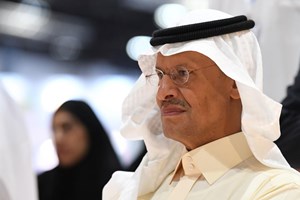Saudis lead OPEC+ majority opinion against February supply increase
(Bloomberg) --A majority of OPEC+ members including Saudi Arabia were opposed to increasing oil output again next month, while Russia was proposing the maximum supply hike allowed by the group’s agreement.
The difference of opinion between the two de-facto leaders of OPEC+ could make for another tricky meeting. While Russia appeared to be outnumbered, the group typically requires a consensus among all members before concluding talks.
The initial negotiating position of Saudi Energy Minister Prince Abdulaziz bin Salman, who has consistently sought to keep a tight rein on supply, was to reverse the 500,000 barrel-a-day production increase the group made this month, delegates said. He also indicated he would accept rolling over current output levels into February, they said.
In his opening remarks, the prince highlighted the risks to the oil market from a more infectious strain of the coronavirus, which has heightened the economic risks even as the roll-out of vaccines has buoyed prices.
“At the risk of being seen as a killjoy in the proceedings, I want to urge caution,” Prince Abdulaziz said at the start of the group’s video conference on Monday. “The new variant of the virus is a worrying and unpredictable development.”
Algeria, Nigeria, Oman, Iraq, Kuwait and the United Arab Emirates were also in favor of holding supply steady in February, delegates said, asking not to be named because the meeting was private. Kazakhstan supported Russia’s position.
Russia’s Deputy Prime Minister Alexander Novak gave no public signal about his position, saying the market was in “healthier shape” but also warning of “uncertainties ahead.” Yet behind closed doors, delegates said he reiterated his position that the alliance should boost supply by 500,000 barrels a day next month, matching January’s increase.
“Russia is currently focusing on market share while a number of other countries value prices,” Iran’s Oil Minister Bijan Namdar Zanganeh told reporters, according to the ministry’s news service Shana.
Cautious Approach
The Organization of Petroleum Exporting Countries and its allies are currently idling 7.2 million barrels a day, or about 7% of world supplies, and plan to return a further 1.5 million barrels a day in installments no larger than 500,000 barrels a day over the coming months.
The group is already taking a cautious approach, agreeing in December to meet every month -- rather than just a few times a year -- in order to fine-tune production levels more precisely and avoid capsizing the price recovery they spent most of 2020 working to achieve.
Talks between a panel of ministers that oversees the OPEC+ deal earlier on Monday concluded without a policy recommendation, leaving the decision to the full meeting of the entire group that’s now underway.
Other prominent voices from the alliance have echoed Prince Abdulaziz’s caution. “There’s a need to be wary of the repercussions of the second wave of the pandemic,” state-run Kuwait News Agency reported on Monday, citing a statement from Oil Minister Mohammed Alfares.
OPEC Secretary-General Mohammad Barkindo said at Sunday’s preparatory meeting that “there are still many downside risks to juggle.”
Brent crude, the international benchmark, fell 1% to $51.31 a barrel as of 6:32 p.m. in London. Prices rallied earlier in the day on strong demand from Asia due to freezing weather, but faltered later amid signs of widening lockdowns in Europe.
The case for another small OPEC+ output increase in February is underpinned by a recovery in the oil prices, which have gained more than a third since the emergence of the first Covid vaccines last year.
The immunizations have created a “healthier” outlook for oil consumption, which will soon “shift from reverse to forward gear,” Barkindo said at the Joint Technical Committee meeting on Sunday. The panel assesses implementation on behalf of the 23-nation alliance.
Russia’s Novak said last month that OPEC+ should proceed with its supply increase because prices are in an optimal range of $45 to $55 a barrel. If OPEC+ refrains from bolstering exports, its competitors will simply fill the gap, he said.
“The market has underlying support and as such should shrug off a modest increase in OPEC+ supply,” said Doug King, chief investment officer of the Merchant Commodity Fund, which manages $170 million.
A production boost might also come as a relief to OPEC+ members like Iraq. Baghdad is engulfed in a mounting economic crisis that is only exacerbated by limits on oil sales, and is struggling to get through a backlog of overdue output cuts from 2020.
Barkindo’s Caution
Yet there are also reasons to think the group will take a more cautious approach.
Restrictions on movement are still in place in a number of countries amid a new strain of the virus, Barkindo said. It’s too soon to know how key sectors of the economy will be affected, and for the tourism and leisure industries the return to pre-crisis levels could take a couple of years.
Oil inventories in developed nations remain 163 million barrels above their five-year average, Barkindo added. Despite the market’s rebound, crude prices are far below the levels most OPEC members need to cover government spending.
While the IEA anticipates no fresh surplus, it warned that the existing inventory overhang will linger to the end of the year if OPEC+ opens the taps.
“We think the producer group will opt to forgo any further production increases for February with Covid-19 cases continuing to climb and the slower than expected vaccine roll-out,” said Helima Croft, chief commodities strategist at RBC Capital Markets LLC.




